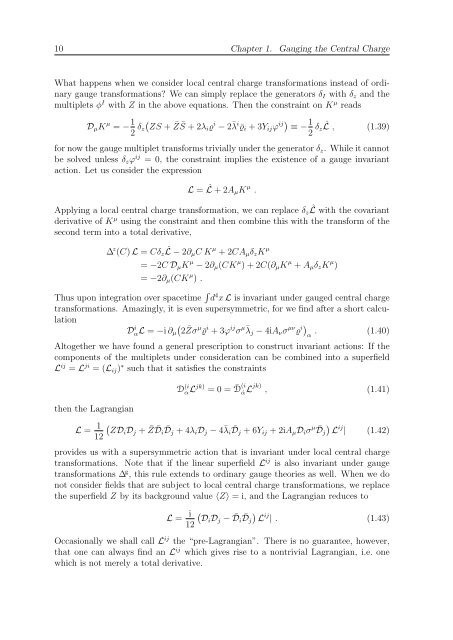N=2 Supersymmetric Gauge Theories with Nonpolynomial Interactions
N=2 Supersymmetric Gauge Theories with Nonpolynomial Interactions
N=2 Supersymmetric Gauge Theories with Nonpolynomial Interactions
You also want an ePaper? Increase the reach of your titles
YUMPU automatically turns print PDFs into web optimized ePapers that Google loves.
10 Chapter 1. Gauging the Central Charge<br />
What happens when we consider local central charge transformations instead of ordinary<br />
gauge transformations? We can simply replace the generators δI <strong>with</strong> δz and the<br />
multiplets φ I <strong>with</strong> Z in the above equations. Then the constraint on K µ reads<br />
DµK µ = − 1<br />
2 δz<br />
<br />
ZS + Z¯ S ¯ + 2λiϱ i − 2¯ λ i ¯ϱi + 3Yijϕ ij ≡ − 1<br />
2 δz ˆ L , (1.39)<br />
for now the gauge multiplet transforms trivially under the generator δz. While it cannot<br />
be solved unless δzϕ ij = 0, the constraint implies the existence of a gauge invariant<br />
action. Let us consider the expression<br />
L = ˆ L + 2AµK µ .<br />
Applying a local central charge transformation, we can replace δz ˆ L <strong>with</strong> the covariant<br />
derivative of K µ using the constraint and then combine this <strong>with</strong> the transform of the<br />
second term into a total derivative,<br />
∆ z (C) L = Cδz ˆ L − 2∂µC K µ + 2CAµδzK µ<br />
= −2C DµK µ − 2∂µ(CK µ ) + 2C(∂µK µ + AµδzK µ )<br />
= −2∂µ(CK µ ) .<br />
Thus upon integration over spacetime d 4 x L is invariant under gauged central charge<br />
transformations. Amazingly, it is even supersymmetric, for we find after a short calcu-<br />
lation<br />
D i <br />
αL = −i ∂µ 2Zσ ¯ µ i ij<br />
¯ϱ + 3ϕ σ<br />
µ¯ λj − 4iAνσ µν ϱ i<br />
. (1.40)<br />
α<br />
Altogether we have found a general prescription to construct invariant actions: If the<br />
components of the multiplets under consideration can be combined into a superfield<br />
Lij = Lji = (Lij) ∗ such that it satisfies the constraints<br />
then the Lagrangian<br />
D (i<br />
αL jk) = 0 = ¯ D (i<br />
˙α Ljk) , (1.41)<br />
L = 1 <br />
ZDiDj +<br />
12<br />
¯ Z ¯ Di ¯ Dj + 4λiDj − 4¯ λi ¯ Dj + 6Yij + 2iAµDiσ µ <br />
Dj<br />
¯ ij<br />
L | (1.42)<br />
provides us <strong>with</strong> a supersymmetric action that is invariant under local central charge<br />
transformations. Note that if the linear superfield L ij is also invariant under gauge<br />
transformations ∆ g , this rule extends to ordinary gauge theories as well. When we do<br />
not consider fields that are subject to local central charge transformations, we replace<br />
the superfield Z by its background value 〈Z〉 = i, and the Lagrangian reduces to<br />
L = i <br />
DiDj −<br />
12<br />
¯ Di ¯ ij<br />
Dj L | . (1.43)<br />
Occasionally we shall call L ij the “pre-Lagrangian”. There is no guarantee, however,<br />
that one can always find an L ij which gives rise to a nontrivial Lagrangian, i.e. one<br />
which is not merely a total derivative.

















